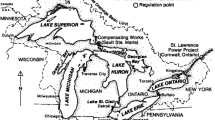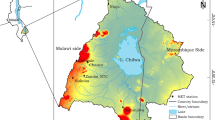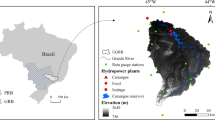Abstract
In this study, we compared the frequency and timing of drought and wetness indices of annual mean water levels in the North American Great Lakes as they relate to teleconnection indices over the period from 1918 to 2012. In terms of timing, drought occurred in the Great Lakes watershed during the 1920, 1930 and 2000 decades, and was very intense in the East during the 1930’s and in the West during the 2000 decade. The main cause of extreme drought episodes in the 1920’s and 1930’s was a decrease in precipitation, while the 2000 decade drought is thought to be caused by increased water temperature (enhanced evaporation) due to a significant decrease in winter ice cover. The 1970 and 1980 decades were very wet over the whole watershed as a result of increased precipitation in the region. The succession of these dry and wet episodes did not have the same impacts on the stationarity of annual mean water levels in the five Great Lakes. Lake Superior shows an abrupt shift in mean in 1999, but a smoothed shift in variance since 1994, whereas Lake Erie shows four abrupt shifts in mean. Lake Ontario also shows the two first abrupt shift in mean and one abrupt change in variance. Extreme drought indices are negatively correlated with the North Atlantic Oscillation (NAO) for the two shallowest lakes (Ontario and Erie). In contrast, extreme wetness indices are positively correlated with PDO (positive correlation) and SOI (negative correlation) for Lake Superior only.



Similar content being viewed by others
References
Angel JR (1996) Cyclone climatology of the Great Lakes. IDEALS, Illinois State Water Survey Publication MP-172, technical report
Assani AA, Landais D, Mesfioui M, Matteau M (2010) Relationships between the Atlantic multidecadal oscillation index and variability of mean annual flows for catchments in the St. Lawrence watershed (Québec, Canada) during the past century. Hydrol Res 41:115–125
Assani AA, Chalifour A., Légaré G, Manouane C.-S, Leroux D (2011) Temporal regionalization of 7-day low flows in the St.Lawrence watershed in qubec (Canada). water resour. Manage 25: 3559–3574.
Assel RA, Quinn FH, Sellinger CE (2004) Hydroclimatic factors of the recent record drop in Laurentian great lakes water levels. Bull Am Meteorol Soc 85:1143–1151
Austin J, Colman S (2007) Lake superior summer water temperature are increasing more rapidly than regional air temperature: a positive ice-albedo feedback. Geophys Res Lett 34:L06604. doi:10.1029/2006GL029021
Barlow M, Nigam S, Berbery EH (2001) ENSO, Pacific decadal variability, and U.S. summertime precipitation, drought, and stream flow. J. Climate 14:2105–2128
Biron S, Assani AA, Frenette J-J, Massicotte P (2014) Comparison of lake Ontario and St. Lawrence River Hydrologic droughts and Their Relationship to Teleconnection Indices. Water Resourc Res 50:1396–1409. doi:10.1002/2012WR013441
Bonsal BR, Shabbar A (2008) Impacts of large-scale circulation variability on low streamflows over Canada: a review. Can Water Res J 33:137–154
Brown RS (2008) Analysis of snow cover variability and change in Québec 1948-2005. Hydrol Process 24:1929–1954.
Cengiz TM (2011) Periodic structures of great lakes levels using wavelet analysis. J Hydrol Hydromech 59:24–35
Changnon SA (2004) Temporal behavor of levels of the Great Lakes and climate variability. J Great Lakes Res 30:184–200
Clites AH, Quinn FH (2003) The history of lake superior regulation: implications for the future. J Great Lakes Res 29:157–171
Cook BI, Seagar R, Miller RL (2011a) Atmospheric circulation anomalies during two persistent north American droughts: 1932–1939 and 1948–1957. Clim Dyn 36:2339–2355
Cook BI, Cook ER, Anchukaitis KJ, Seagar R, Miller RL (2011b) Forced and unforced variability of twentieth century north American droughts and pluvials. Clim Dyn 37:1097–1110
Déry SJ, Wood EF (2005) Decreasing river discharge in northern Canada. Geophys Res Lett 32:L10401. doi:10.1029/2005GL022845
Enfield AM, Mestas-Nuñez AM, Trimble PJ (2001) The Atlantic multidecadal oscillation and its relation to rainfall and river flows in the continental U.S. Geophys Res Lett 28:2077–2080
Gronewold AA, Fortin V, Logfren B, Clites A, Stow CA, Quinn F (2013) Coasts, water levels, and climate change: a great lakes perspective. Clim Chang 120:697–711
Hanrahan J, Roebber P, Kravtsov S (2014) Attribution of decadal-scale lake-level trends in the Michigan-Huron system. Water 6:2278–2299
Kingston DG, Lawler DM, McGregor GR (2006) Linkages between atmospheric circulation, climate and streamflow in the northern north Atlantic: research prospects. Prog Phys Geogr 30:143–174
Lentz EE (2006) Great Lakes, grand problem: the impacts of significantly lowered levels on the industries, ecosytems, and individuals in the Great Lakes regions. Coastal Institute IGERT projet report, 22p
Lofgren BM (2004) A model for simulation of the climate and hydrology of the Great Lakes basin. J Geophys Res Atmosph. doi:10.1029/2004.JD004602
Lombard F (1987) Rank tests for changepoint problems. Biometrika 74:615–624
Magnuson JJ, Webster KE, Assel RA, et al. (1997) Potential effects of climate changes on aquatic systems Laurentian great lakes and Precambrian shield region. Hydrol Process 11:825–871
Mazouz R, Assani AA, Quessy JF, Légaré G (2012) Comparison of the interannual variability of spring heavy floods characteristics of tributaries of the St. Lawrence in Quebec (Canada). Adv. Water Res 35:110–120
McBean E, Motiee H (2008) Assessment of impact of climate change on water resources: a long term analysis of the great lakes of North America. Hydrol Earth Syst Sci 12:239–255
Quessy J-F, Favre A-C, Saïd M, Champagne M (2011) Statistical inference in Lombard’s smooth-change model. Environmetrics 22:882–893
Quinn FH (1978) Lake superior regulation effects. Water Res Bull 14:1129–1142
Schubert SD, Suarez MJ, Pegion PG, Koster RD, Bacmeister JT (2004) Causes of long-term drought in the U.S. Great plains. J. Climate 17:485–503
Sellinger CE, Stow CA, Lamon EC, Qian SS (2008) Recent water level declines in the lake Michigan-Huron systems. Environ Sci Technol 42:367–373
Shabbar A (2006) The impact of El-Nino-Southern Oscillation on the Canadian climate. Adv Geo Sci 6:149–153
Wang J, Bai X, Hu H, Clites A, Colton M, Lofgren B (2012) Temporal and spatial variability of great lakes ice cover, 1973–2010. J Clim 25:1318–1329
Author information
Authors and Affiliations
Corresponding author
Rights and permissions
About this article
Cite this article
Assani, A.A., Landry, R., Azouaoui, O. et al. Comparison of the Characteristics (Frequency and Timing) of Drought and Wetness Indices of Annual Mean Water Levels in the Five North American Great Lakes. Water Resour Manage 30, 359–373 (2016). https://doi.org/10.1007/s11269-015-1166-9
Received:
Accepted:
Published:
Issue Date:
DOI: https://doi.org/10.1007/s11269-015-1166-9




